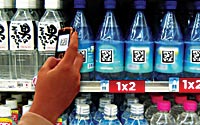 By all indications, mobile traffic and m-commerce made impressive gains during the holiday season as a growing number of people turned their handsets into personal shopping assistants. New research from the Pew American & Internet Life Project further highlights that trend, showing
that more than half (52%) of adult cell phone owners used their devices while in a store to get help with purchasing decisions.
By all indications, mobile traffic and m-commerce made impressive gains during the holiday season as a growing number of people turned their handsets into personal shopping assistants. New research from the Pew American & Internet Life Project further highlights that trend, showing
that more than half (52%) of adult cell phone owners used their devices while in a store to get help with purchasing decisions.
Specifically, 38% used their phone to call a friend
for advice while in a store, 24% looked up product reviews online in-store, and one-quarter checked pricing online to see if they could get a better deal elsewhere.
Furthermore, one in five
“mobile price-matchers” made their most recent purchase from an online store rather than a physical location. More than one-third (37%) decided not to buy the product at all, 35% bought it
at that store and 8% got it at another store.
That last finding should not do much to diminish retailers’ fears that shoppers are increasingly using their brick-and-mortar outlets as
showrooms for subsequent purchases at an online or offline competitor.
Breaking down the demographics of in-store mobile use, the Pew study found that cell owners ages 18-49 are much more
likely to use their phones for online product reviews than cell owners ages 50+. The youngest segment of adults -- 18- to-29-year-olds -- were the most active group, with 63% using their
phones either to call a friend for purchase advice or to look up product reviews in-store.
As with other kinds of mobile behavior, ethnic minorities outpace whites when it comes to
in-store mobile use. More than half (53%) of nonwhites called a friend for advice or looked up product reviews via mobile while shopping compared to 45% of whites. The difference between the two
groups was especially pronounced when it came to looking up reviews -- with a third of non-whites doing this versus 21% of whites.
Urban and suburban cell owners were about twice as
likely as rural cell owners to have recently used their phone to look up online reviews of a product they found in a physical store.
Looking at real-time pricing checking, the Pew research
again showed the 18-49 demo was most likely to compare prices via mobile. In contrast to getting advice and checking reviews -- where the sexes were about the same -- men were more likely to
compare prices than women, at 31% to 20%. And ethnic minorities far outstripped their white counterparts in price-match, by 38% to 20%.
Those with at least some college education and
urban and suburban dwellers were also much more likely to do in-store price checking. More affluent mobile users were also more likely to do so, but the difference was not significant between those
making more or less than $50,000 a year, at 28% versus 25%.
The Pew study noted that checking reviews and pricing often go together. Of the 33% of cell owners who used their phone in-store to
look up either product reviews or prices online, roughly half (representing 17% of all cell owners) used their phones to do both.
In a panel focused on mobile results from the holiday season
at the Mobile Insider Summit last week, Dan Israel of SapientNitro explained that retailers are coping with the era of “radical transparency” in pricing brought about by
smartphone-wielding shoppers. He said the Pew findings released today only underscored the challenge physical stores face from the rise of the mobile-savvy shopper.
“It demonstrates that
an opportunity, as well as a sense of urgency, exists for retailers to engage customers before they arrive at a brick-and-mortar, and continue the conversation after the visit to a
brick-and-mortar,” said Israel, who leads SapientNitro’s mobile practice. “What matters now is engagement and providing utilitarian services, not just value centered on price
alone.”
The Pew study results were based on a telephone interviews with a nationally representative sample of 1,000 U.S. adults from Jan. 5-8. Of that group, 600 were reached by landline
and 400 by mobile phone. The study has a margin of sampling error of plus or minus 3.9 percentage points.